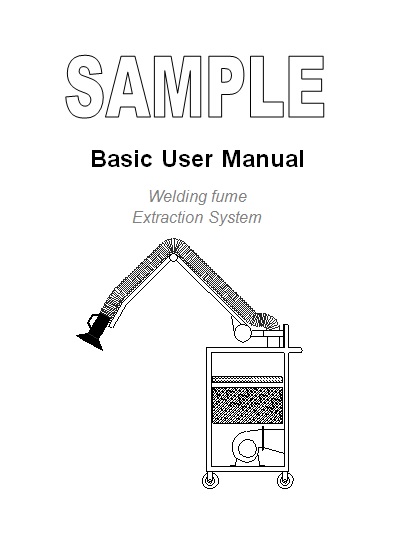Basic LEV User Manual

It is recommended practice to supply a user manual with LEV systems. This resource is a very basic user manual for a portable fume extraction system with swinging arm. It is a very brief template and just tells the client what they need to know and what they should be doing.
In this example the technical information was supplied in our LEV TExT report and Commissioning report.
When writing user manuals in the UK we recommend you ensure that the requirements of HSG258 are met.
Taken from HSG258 on User manuals and log books:
A user manual and logbook should be supplied as part of the design, installation and commissioning process. They contain guidance and standards for the employer to maintain the LEV and also for the LEV examiner (see Chapter 10).User manual
When buying virtually any machine, it comes with a user manual. LEV systems should be no different.
A manual should cover how to use the system, how to maintain it, the spares available and a list of things that can go wrong. It should contain an exploded diagram naming key components of the LEV.
The employer, as client and owner of the LEV system, requires a user manual because: they may not understand the technicalities of the LEV system; LEV checking and maintenance will improve with good instructions and guidance; it will assist the examination and test of the LEV system.A comprehensive user manual for LEV should be in two parts: simple ‘getting started’ instructions (to be read by most people); and detailed technical information for service providers and maintenance/repair engineers.
The detailed technical information would usually include: the purpose and description of the LEV system, including diagrams and drawings; how to use the LEV; signs of wear and control failure; the schedule, frequency and description of checks, maintenance and replacement; a detailed description of the specific statutory ‘thorough examination and test’ requirements and benchmarks; the performance information from commissioning; a listing of replaceable parts (and part numbers).
PurposeThere should be a description of what the LEV system is designed to control and how it achieves control.
Controlling airborne contaminants at work Page 79 of 109 Health and Safety ExecutiveDetailed description
The detailed description would usually include: Component specification and materials of construction and component serial numbers. The designed face velocities of all hoods and the duct velocities. Where the system components have ‘type test’ reports, these should be included. Make-up air arrangements. The measurement and test points, and the measurements and tests required. This includes testing alarms. For systems that use water, it includes tests of water quality. Where necessary, tests also include light levels at the work position. Maintenance and cleaning frequencies, eg fan blades, filters. Checks for articles blocking LEV and how to avoid contaminant build up. Correct operator behavior in using the system, eg moveable hood positioning in relation to a source. Any special requirements for waste disposal.
Drawing
A drawing of the system should include identified components and, where appropriate, their serial numbers, showing: Hoods, including air inlets and if appropriate, their capture zone. Ductwork runs (rigid and flexible), bends and junctions, contractions and expansions. Control dampers and valves. Monitoring equipment, eg manometers. Measurement and test positions and (if necessary) sampling positions. Access hatches. Air cleaner (if fitted). Air mover. Discharge. Monitors and alarms.
Operation and use
The details of operation and use could include: Identification of adjustable controls that affect the system’s performance, eg dampers. The position of hoods, sash openings etc for optimum performance. Operator practice, including positioning of process equipment and methods of working. (This needs consultation with the employer and employees.) Other factors affecting LEV performance, such as draughts from open doors or the use of additional fans for cooling.

